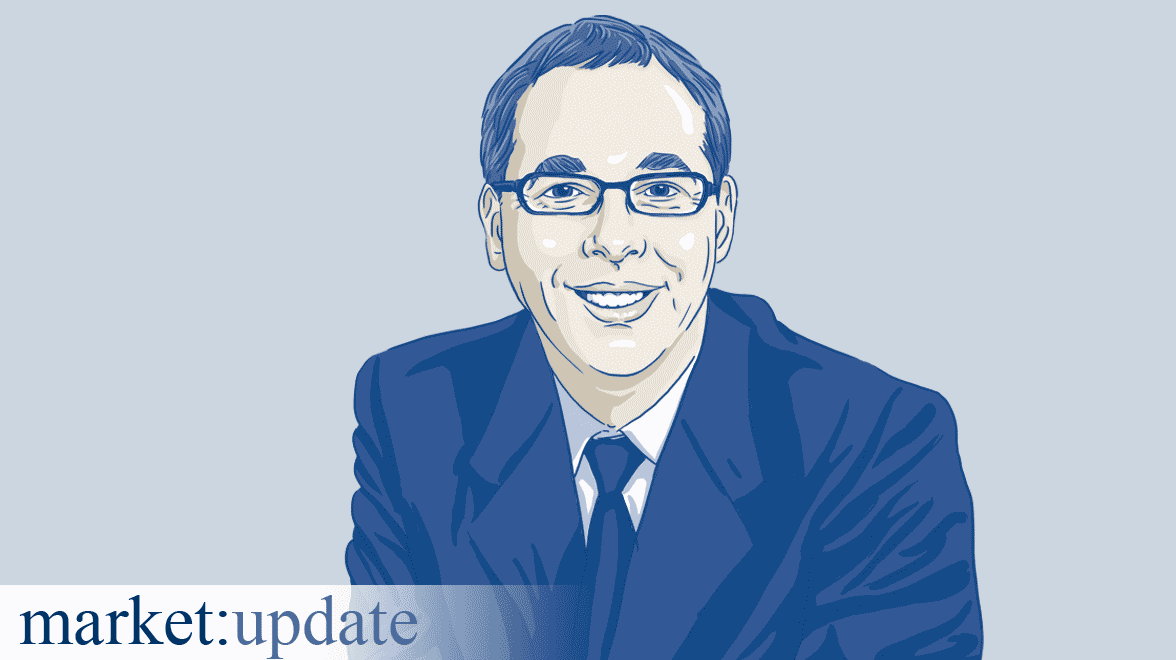Outlook for the 4th quarter: Increasing signs of downturn in the global economy
Bond markets: Yield increases on both sides of the Atlantic
European government bonds suffered heavy losses in the third quarter. The index of euro zone government bonds from ICE BofA recorded a loss of 2.5 percent. The reasons for this were, on the one hand, the two key interest rate increases by the European Central Bank (ECB) in the third quarter and, on the other hand, the rapid rise in yields on US government bonds, which spilled over into German government bonds. Corporate bonds with an investment grade rating were able to outperform government bonds and recorded a gain of 0.3 percent. European high-yield bonds also outperformed and recorded a gain of 1.7 percent – in both cases according to ICE BofA indices. The positive performance of corporate bonds was due to narrowing spreads, which was unusual in an environment where the ECB raised the key interest rate in two steps and economic data tended to deteriorate.
The yield on a 10-year government bond can also be seen as the average expected key interest rate over ten years plus the risk premium. The rise in yields in the third quarter was caused on the one hand by the fact that both the US Federal Reserve and the ECB signaled they would not lower the key interest rate so quickly. Financial markets therefore had to price in fewer key interest rate cuts in the coming years. On the other hand, there was also pressure on the risk premium. Government deficits in the US could get out of hand in the coming years because Medicare and Social Security payments will increase significantly due to the baby boomers entering retirement. Runaway deficits mean the US government will have to issue a significant number of government bonds in the next few years. This year alone, the government deficit is expected to be around USD 2.0 trillion. At the same time, the US Federal Reserve is reducing its balance sheet and selling government bonds at a rate of about USD 1.0 trillion per year. The upcoming wave of issuance is hitting fewer and fewer countries that invest their foreign exchange reserves in the US government bond market. The result is an increase in the risk premium for US government bonds, which is also transmitted to Europe. We see the risk that the yield on 10-year US government bonds could rise to 5.5 percent and on 10-year Bunds to 3.5 percent.
Stock markets: Signs of a downturn in the global economy are increasing
In the third quarter, prices on the international stock markets recorded losses: the MSCI Europe lost about -2.0 percent. In comparison, the MSCI World and the MSCI Emerging Markets Index lost 2.5 percent and 1.3 percent, respectively – both in local currency. Interestingly enough, forward earnings estimates over the next twelve months in Europe and the United States improved over the quarter. Weak economic data and the associated concerns of market participants for future profit development were therefore not the reason for the price correction. Rather, the reason was the decline in the price-earnings ratio. According to our analyses, inflation and the yield on 10-year government bonds are the main factors affecting the price-earnings ratio. Inflation fell in the third quarter, but the government bond market was turbulent and government bond yields rose markedly.
At the end of the quarter, there were more signs of a downturn in the global economy. In the fourth quarter, the optimistic earnings expectations of analysts could therefore come into question. We also see risks that the bond markets could remain turbulent in the fourth quarter. A weakening global economy usually contributes to a decline in government bond yields. However, yields could still rise in this cycle as a risk premium for long-dated government bonds could increasingly be priced in – against the backdrop of ballooning government deficits in the US. A further decline in price-earnings ratios on the international stock markets therefore seems quite likely in the fourth quarter. However, a lower valuation of the international stock markets also means that medium-term performance opportunities are on the rise again.
The outlook for the fourth quarter on the international stock markets is subdued, but this is probably a normal cyclical phenomenon. Every downturn comes to an end and is replaced by a new upswing. Historical observation also shows that recessions are significantly shorter than upswings. For example, since 1945, the US economy has been on the upswing about 87 percent of the time; in 75 years there have been twelve recessions, each lasting about ten months on average.
Euro zone economy: Falling inflation, but hurdles for key rate cuts are still high
The ECB's monetary policy is showing the first signs of success. In September, inflation fell to 4.3 percent, while it was still at 5.5 percent in June. Despite the noticeable decline in inflation, the ECB continued its hiking cycle in the third quarter, raising the key interest rate in July and September by 0.25 percentage points each to 4.0 percent. Currently, market participants estimate the neutral key interest rate level at 2.0 to 2.5 percent – the ECB is thus pursuing a restrictive monetary policy. One result is slowed economic growth, as the purchasing managers' and business climate indices signaled in September. They are consistent with economic growth slightly below zero.
It can be assumed that the key interest rate increases have not yet had their full effect and that further restrictive impulses could still be in the pipeline, so to speak. It is therefore possible that economic data in the euro zone might weaken further. At the same time, the labor market remains strong. The ageing of society means that many employees will retire in the next few years. Companies are therefore refraining from making redundancies, as the workforce is likely to shrink. In addition, many companies in the upswing after the relaxation of covid measures also experienced that they can no longer find the employees they need to expand production. For this reason, too, the hurdle for layoffs is very high. Against this background, the unemployment rate is likely to remain stable in the next few months. This could strengthen the bargaining position of workers and ensure that wage dynamics remain high. At the same time, there are also positive scenarios for the European economy: European industry could soon have sufficiently cleared its inventories, which would revive production. There could also be positive spillover effects from the US. Economic data in the upcoming weeks will show which way the European economy is trending. Against this backdrop, the hurdle for ECB rate cuts is likely to be rather high.
US economy: Slight economic slowdown likely in the fourth quarter
The US economy seems to have recorded a significant acceleration in growth in the third quarter. Apparently, the rescue measures after the bankruptcy of Silicon Valley Bank and other banks were able to help stabilize lending. At the same time, financial markets responded positively to the Federal Reserve's extensive liquidity programs in the wake of the bank bailout, so that macroeconomic financing conditions improved – with positive effects on economic growth.
At the same time, the dramatic interest rate hikes by the US Federal Reserve do not yet seem to have had a major impact on the real economy. For example, most private households have financed their houses since the Great Financial Crisis with 30-year mortgage loans and are thus not affected by the rise in interest rates. In addition, many companies also financed themselves at favorable conditions before the rise in interest rates last year, so that the higher interest rates have hardly any impact on their financing costs. In addition, many companies have high cash balances, which are now paying high interest rates and have even contributed to a decline in the net interest burden for many companies over the course of the year. The resilience of the US economy is undoubtedly impressive.
Nevertheless, the first signs of a downturn also increased in the USA towards the end of the quarter: the previously robust residential real estate market cooled noticeably, and defaults on consumer and car loans as well as credit cards increased. Business bankruptcies also increased. In addition, economic data showed a rather mixed picture. Economic growth could therefore weaken in the fourth quarter compared to the third quarter – but it is currently unclear how much. Against the backdrop of high uncertainty, it is questionable whether the US Federal Reserve will take another interest rate step in November. In our view, the probability is currently 50 percent, as we expect economic data to remain weak. Inflation in the USA has also been very moderate recently, so that the US Federal Reserve is not under pressure to raise the key interest rate due to inflation risks.
Asian economy: Japan's exports benefit from a weak yen, China would have to fight weak consumption
Japanese economic data was resilient in the third quarter: the purchasing managers' indices in Japan developed significantly better in September than they did in Europe and the USA. This was due to the continuation of the ultra-loose monetary policy in Japan, while monetary policy in the USA and Europe was rather restrictive. Therefore, a weakness in the exchange rate of the Japanese yen could also be observed, and this helped Japanese exporters. The downside of the yen's weakness, however, is that import prices rose markedly – as did inflation. In August, the inflation rate was 3.2 percent. However, the inflationary impulse of higher import prices has not yet been transmitted to the domestic economy. The trend growth rate of wages was only about 1.8 percent in August. However, in order to achieve the inflation target of 2.0 percent on a sustained basis, wages must rise by about 3.0 percent. With stable corporate profit margins, the unit labor cost growth rate (wages 3.0 percent – productivity 1.0 percent = unit labor cost growth of 2.0 percent) is equal to domestically generated inflation. The Bank of Japan is therefore likely to wait until wage dynamics have accelerated before adjusting its monetary policy. In doing so, however, it risks further weakening of the Japanese yen exchange rate.
The weak economic data in the second quarter forced the Chinese government to act. Numerous measures were introduced to stabilize the economy. Interestingly, the measures again focused on the real estate market and infrastructure programs, i.e. on areas that are actually already exhausted. The structural weakness in consumption was not addressed. According to local economists, there are ideological reservations against a consumer society within the Chinese government. The measures adopted are therefore likely to stimulate the Chinese economy only temporarily and fizzle out again towards the end of the year. At the same time, against the backdrop of the economic downturn in the developed economies, Chinese exports are likely to weaken. The Chinese government could thus soon come under pressure again to stabilize the economy. In our view, a lasting revival of Chinese consumption is therefore essential.
More articles
This document published by Metzler Asset Management GmbH [together with its affiliated companies as defined in section 15 et seq. of the German Public Limited Companies Act (Aktiengesetz – "AktG”), jointly referred to hereinafter as “Metzler“] contains information obtained from public sources which Metzler deems to be reliable. However, Metzler cannot guarantee the accuracy or completeness of such information. Metzler reserves the right to make changes to the opinions, projections, estimates and forecasts given in this document without notice and shall have no obligation to update this document or inform the recipient in any other way if any of the statements contained herein should be altered or prove incorrect, incomplete or misleading.
Neither this document nor any part thereof may be copied, reproduced or distributed without Metzler‘s prior written consent. By accepting this document, the recipient declares his/her agreement with the above conditions.
 Deutsch
Deutsch English
English


